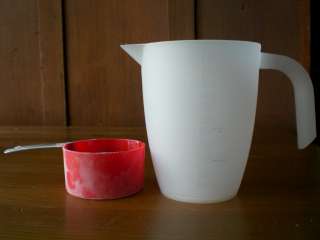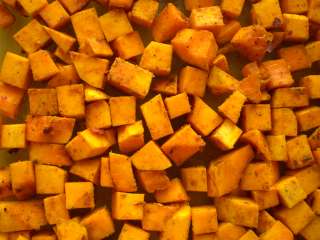Right v. Wrong
Marc has been baking loads of bread lately. He picked up a hardcover breadmaking bible at the bookstore last weekend and has since been churning out the ciabatta. This isn’t the first time he’s gone through a flurry of baking, it happened just before we left on The Voyage and was cut short because we had to go. We threw out half-full bags of five different kinds of flour and now, though we are only here in Berkeley for five more weeks, we already have four kinds of flour and I suspect we’ll be burdened with even more when it comes time to pack up. When I asked him why he got into bread specifically, he said he liked the feel of it and how a gloopy mass of dough can be transformed into a loaf of bread. When he found a page in the bread bible that used math to explain the ratios of key ingredients, he was – and this is the only word to describe it – gleeful. Full of glee because of math and baking. I like seeing him happy but I don’t think I can really appreciate math in the same way. We both love to cook, though clearly we are drawn to different elements of the practice: where he likes to measure with spoons, I like to measure with my eyes; where I estimate cooking time, he googles the correct boiling time of corn on the cob.
 One disagreement that will forever be simmering under the surface of our kitchen dynamic is the difference between dry-measure and liquid-measure. Marc insists that one cup of dry equals one cup of liquid and I insist otherwise; surely there is a reason why they make nested measuring cups and separate ones with spouts. There have been experiments conducted in the kitchen to prove and disprove our opposing views and the result usually ends with a discussion of molecular make-up of liquids and solids and then with an agreement to disagree.
One disagreement that will forever be simmering under the surface of our kitchen dynamic is the difference between dry-measure and liquid-measure. Marc insists that one cup of dry equals one cup of liquid and I insist otherwise; surely there is a reason why they make nested measuring cups and separate ones with spouts. There have been experiments conducted in the kitchen to prove and disprove our opposing views and the result usually ends with a discussion of molecular make-up of liquids and solids and then with an agreement to disagree.
An extension of the Measuring Conflict is the practice of following the recipe. I read the step-by-step instructions and follow along but I’m highly prone to changing the details to fit my preferences.  Living in Calgary at a high altitude for so long, I’m well in the habit of adjusting baking recipes to compensate for the pressure and that habit has further manifested itself in my cooking. If it seems silly to add three tablespoons of butter where two would do, then I’ll go with the two; if a recipe calls for fresh tarragon, I’ll double the amount because I love that herb. Marc, on the other hand, is much more scientifc about things. If the interweb says that scallops must be cooked at a temperature of 360°F for a period of time no greater than 2.6 minutes, then we’ll have to go out and buy a thermometer and a timer. His method yields perfectly cooked scallops every timewhile my method may yield perfectly cooked scallops some of the time, with lots of tarragon. Our focus is different, my results vary.
Living in Calgary at a high altitude for so long, I’m well in the habit of adjusting baking recipes to compensate for the pressure and that habit has further manifested itself in my cooking. If it seems silly to add three tablespoons of butter where two would do, then I’ll go with the two; if a recipe calls for fresh tarragon, I’ll double the amount because I love that herb. Marc, on the other hand, is much more scientifc about things. If the interweb says that scallops must be cooked at a temperature of 360°F for a period of time no greater than 2.6 minutes, then we’ll have to go out and buy a thermometer and a timer. His method yields perfectly cooked scallops every timewhile my method may yield perfectly cooked scallops some of the time, with lots of tarragon. Our focus is different, my results vary.
There is a programme that we watch with equal rapture but which also serves to exacerbate his methodological rigidity. America’s Test Kitchen on PBS, with their test kitchens and and their tool comparisons and their “reserve 3/4c. of the cooking liquid” feeds right into his mathmatically logical mind. If the Vulcans had a cooking show, Marc would be their biggest fan, especially if it was hosted by T’Pol. However, as derisive as I’m sure I sound about his method, I have to admit that his googling and his obsessive use of the measuring spoons has added much clarity to our cooking.
But let me further elaborate; allow me to refer to our recent lunch of Kraft Dinner as an example. (I am loathe to admit that we will occassionaly revert to this childish nonsense for lunch, but in the interest of prooving a point, I must proceed.)
I am making KD. Marc walks into the kitchen while the pasta is boiling.
“Sorry- anything I can do to help?”
“Nah, it’s just KD.”
“OK, did you set the timer for the pasta?”
“Of course not, why?”
“Gah! How can you not set the timer? How do you know when it’s done?”
“What – I’ll know it’s done when it’s done. I’ve cooked pasta once or twice before.”
“Let me get the butter; how much do you need?”
“Like the measurement on the package? I have no idea, I’ll just put in enough.”
“How can you do this? It’s on the box for a reason- it was scientifically calculated to taste perfect.” he says, while rooting through the paper recycling.
“Whatever, I’ve been making KD forever and I never measure. You’re telling me you measure every time?”
“Of course! Why wouldn’t you measure?!”
“Trust me,” I say as I toss in a lump of butter, “it will taste good even if don’t measure.”
“But you just put in, like, half the butter it called for.”
“So?! Trust me!”
“Oh fine, I’m monté au beurre-ing mine when you’re done.”
“Oh, fine.”
Miraculously, the KD that I produced without measuring the butter or the milk tasted good. And the bit about the direction on the box being “scientifically calculated” was a direct quote.
July 23rd, 2007 at 10:13 am
I’m not sure how Janet can “agree to disagree” that a cup of water measured in the red cup above and then poured into a liquid measuring cup isn’t still a cup. I’ve done this in front of her. In doing some research online, there is something called “dry measurements,” but they are not used in U.S. recipes and they typically are used to measure things like “a quart of strawberries” rather than a “cup of flour.”
KD should be cooked for 7minutes. No more, no less. It’s better with all the butter, but best with extra butter and less milk. Whole milk is better than skim. The milk and butter should be heated in the microwave to keep the pasta hot.
July 23rd, 2007 at 10:16 am
See?!
July 23rd, 2007 at 8:04 pm
http://www.washingtonpost.com/wp-dyn/content/article/2005/12/20/AR2005122000295.html
Reading this, I am not certain which of you is really “right” about the measuring but the author is a professor of chemistry so it might add to the debate.
July 24th, 2007 at 1:21 am
Okay, so on the KD issue I say it was invented with kids in mind; it’s generally eaten with fingers, dropped on floors or in laps and sometimes finds its way into ears and noses and when it’s completely cold and sticky it might make its way into a mouth only to be rolled around until all the cheesy goo is off and then taken out and fed to the dog. Given this, I say make it without a care – everyone will still love it.